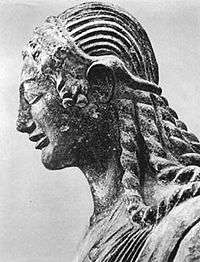Murlo cowboy

Artist's impression of the Murlo cowboy.
The name Murlo cowboy[1] is applied to a set of more than a dozen Etruscan acroteria from the sixth century BCE held at the museum of the Poggio Civitate at Murlo in the Province of Siena, Tuscany, Italy.
The major piece of the group is a seated terracotta statue with a wide-brimmed hat reminiscent of a cowboy hat.[2] The statue probably represents a haruspex.
On Etruscan buildings, statues of gods, heroes, or ancestors were often placed on the ridges of roofs to protect votive offerings.
References
- ↑ Larissa Bonfante, Etruscan life and afterlife: a handbook of Etruscan studies, p. 133.
- ↑ Jean-Paul Thuillier, Les Étrusques, la fin d'un mystère, p. 38–39.
Bibliography
- 'The Murlo Cowboy: problems of reconstruction and interpretation' in Deliciae Fictiles, ed. Eva Rystedt, Charlotte Wikander and Örjan Wikander (Acta Instituti Romani Regni Sueciae, series in 4°, vol. 50, Stockholm, 1993) p. 117–121.
This article is issued from Wikipedia - version of the 8/24/2016. The text is available under the Creative Commons Attribution/Share Alike but additional terms may apply for the media files.
